Study on Magnetite Ore Crushing Assisted by Microwave Irradiation
Abstract
:1. Introduction
2. Materials and Methods
2.1. Experimental Principle
2.2. Experimental Methods
3. Results
3.1. Changes of Dynamic Strength
3.2. Changes of the Absorbed Energy
3.3. Changes of Crushing Degree
3.4. Micro-Mechanism of Microwave-Assisted Ore Crushing
3.4.1. Microscopic Explanation of the Change of Crushing Degree
3.4.2. Microscopic Explanation of the Change of Absorbed Energy
3.5. Separate Responses of Minerals to Microwave Irradiation
4. Discussion
4.1. Multi-Stage Impact to Improve Energy Utilization Efficiency
4.2. Prospects of Rock Cracking Methods by Microwave Irradiation
- (1)
- Cyclic microwave irradiation (CMI). According to the microwave response of ore, increasing the energy density can improve the damage degree of ore. Numerical simulations have shown that adding a cooling interval can improve the effect of rock cracking [20]. Therefore, the CMI with “high power irradiation + cooling interval” can be adopted in the breaking process of high-hardness rock, which can not only crack the rock, but also reduce the total power consumption.
- (2)
- Pretreatment of surrounding rock by hydraulic fracturing. In deep excavation engineering, even if a microwave irradiation method is adopted, the strength of the surrounding rock may still be high due to confining pressure (confining pressure causes the microwave-induced cracks to close), which is not conducive to the subsequent mechanical rock breaking. Therefore, hydraulic fracturing pretreatment can be used first to release the high stress near the surrounding rock. Then, microwave irradiation can not only reduce the strength, but also avoid the occurrence of impact disasters such as rock burst.Meanwhile, in the process of hydraulic fracturing, some liquid water will enter the cracks of surrounding rock. Because the of water is very high (more than 70 at room temperature), the liquid water will vaporize rapidly under the microwave irradiation, generating tensile stress and promoting the disintegration of the surface rock. Therefore, the method of “hydraulic fracturing pretreatment + subsequent microwave irradiation” may be more effective in treating surrounding high-stress rock. Figure 15 shows this method of non-blasting rock breaking based on microwave irradiation.
- (3)
- The cracking method of “microwave irradiation + induced electrode release heat”. Metals are microwave reflecting materials. Under microwave irradiation, the electrons in a metal will break away from the bond of the nucleus to form an electric current. In particular, plasma is easily formed at the sharp ends of metal, accompanied by electric sparks that release large amounts of heat. At present, microwave irradiation is used to make metal radiate heat, and some research results have been obtained in the fields of volcanic eruption and ball lightning [53].
5. Conclusions
- (1)
- In terms of weakening dynamic strength, improving absorbed energy, and aggravating the crushing degree, increasing irradiation power takes priority over extending the time.
- (2)
- The direct cause of thermal cracks inside the ore should be the incongruence of the thermal expansion. The more severe the thermal damage, the stronger the stress disturbance, which will increase the absorbed energy of ore.
- (3)
- With the increase of irradiation power, time, and cooling rate, more T-cracks and cleavage tears will appear on the microscopic morphology.
- (4)
- For quartz, calcite, calcium feldspar, and pyroxene, their crystal grain size, diffraction peak intensity, and crystallinity decrease under microwave irradiation, while these parameters of hornblende, olivine, and potassium feldspar do not change significantly. The results show that the factors affecting the behavior of minerals under microwave irradiation are not only related to the dielectric properties, but also related to other factors such as mechanical properties.
- (5)
- Microwave-sensitive minerals such as enstatite and magnetite provide heat, and minerals sensitive to thermal expansion, such as olivine, produce anisotropic deformation and expansion. This will help reduce the wear of crusher and improve energy utilization.
Author Contributions
Funding
Data Availability Statement
Conflicts of Interest
References
- NRC. Energy Efficiency Trends Analysis Tables: Total End-Use Sector—Energy Use Analysis; Office of Energy Efficiency, Natural Resources Canada. 2006. Available online: http://www.oee.nrcan.gc.ca/corporate/statistics (accessed on 5 May 2019).
- Tromans, D. Mineral comminution: Energy efficiency considerations. Miner. Eng. 2008, 21, 613–620. [Google Scholar] [CrossRef]
- SOE. Indicator: HS-33 Energy Use by Sector, State of the Environment, Australian Government, Department of the Environment and Water Resources. 2006. Available online: http://www.environment.gov.au/soe/2006/publications (accessed on 5 May 2019).
- EIA. Energy Information Administration, International, South Africa. 2005. Available online: http://www.eia.doe.gov/emeu/%20international/safrica.html (accessed on 5 May 2019).
- DOE. Profile of Total Energy Use for Us Industry, Industrial Technologies Program; US Department of Energy, Energy Efficiency and Renewable Energy: Washington, DC, USA, 2004.
- DOE. Mining Industry of the Future Fiscal Year 2004 Annual Report, Industrial Technologies Program; US Department of Energy, Energy Efficiency and Renewable Energy: Washington, DC, USA, 2005.
- Chi, G.; Fuerstenau, M.C.; Bradt, R.C.; Ghosh, A. Improved comminution efficiency through controlled blasting during mining. Int. J. Miner. Process. 1996, 47, 93–101. [Google Scholar] [CrossRef]
- Jones, D.; Kingman, S.; Whittles, D.; Lowndes, I. The influence of microwave energy delivery method on strength reduction in ore samples. Chem. Eng. Process. 2007, 46, 291–299. [Google Scholar] [CrossRef]
- Zhang, J.; Zhang, Z.H. Thoughts on ways for energy-saving and consumption reduction in mineral processing. Metal. Mine. 2007, 371, 1–4. [Google Scholar] [CrossRef]
- Radziszewski, P. Developing an experimental procedure for charge media wear prediction. Miner. Eng. 2000, 13, 949–961. [Google Scholar] [CrossRef]
- Peinsitt, T.; Kuchar, F.; Hartlieb, P.; Moser, P. Microwave heating of dry and water saturated basalt, granite and sandstone. Int. J. Min. Miner. Eng. 2010, 2, 18–29. [Google Scholar] [CrossRef]
- Adewuyi, S.O.; Ahmed, H.A.M.; Ahmed, H.M.A. Methods of ore pretreatment for comminution energy reduction. Minerals 2020, 10, 423. [Google Scholar] [CrossRef]
- Fujita, T.; Aoki, T.; Ponou, J.; Dodbiba, G.; He, C.L.; Wang, K.T.; Ning, S.Y.; Chen, H.; Wei, Y.Z. Removal of impurities from shungite via a combination of physical and chemical treatments. Minerals 2021, 11, 245. [Google Scholar] [CrossRef]
- Li, J.; Kaunda, R.; Arora, S.; Hartlieb, P.; Nelson, P. Fully-coupled simulations of thermally-induced cracking in pegmatite due to microwave irradiation. J. Rock Mech. Geotech. 2019, 11, 242–250. [Google Scholar] [CrossRef]
- Hartlieb, P.; Toifl, M.; Kuchar, F.; Meisels, R.; Antretter, T. Thermo-physical properties of selected hard rocks and their relation to microwave-assisted comminution. Miner. Eng. 2016, 91, 34–41. [Google Scholar] [CrossRef]
- Hartlieb, P.; Kuchar, F.; Moser, P.; Kargl, H.; Restner, U. Reaction of different rock types to low-power (3.2 kw) microwave irradiation in a multimode cavity. Miner. Eng. 2018, 118, 37–51. [Google Scholar] [CrossRef]
- Zhu, W.; Gaetani, G.A.; Fusseis, F.; Montesi, L.G.J.; De Carlo, F. Microtomography of partially molten rocks: Three-dimensional melt distribution in mantle peridotite. Science 2011, 332, 88–91. [Google Scholar] [CrossRef] [PubMed] [Green Version]
- Zeng, J.; Hu, Q.; Chen, Y.; Shu, X.; Chen, S.; He, L.; Tang, H.; Lu, X. Experimental investigation on structural evolution of granite at high temperature induced by microwave irradiation. Miner. Petrol. 2019, 113, 745–754. [Google Scholar] [CrossRef]
- Whittles, D.; Kingman, S.; Reddish, D. Application of numerical modelling for prediction of the influence of power density on microwave-assisted breakage. Int. J. Miner. Process. 2003, 68, 71–91. [Google Scholar] [CrossRef]
- Jones, D.; Kingman, S.; Whittles, D.; Lowndes, I. Understanding microwave assisted breakage. Miner. Eng. 2005, 18, 659–669. [Google Scholar] [CrossRef]
- Zheng, Y.; Zhang, Q.; Zhao, J. Effect of microwave treatment on thermal and ultrasonic properties of gabbro. Appl. Therm. Eng. 2017, 127, 359–369. [Google Scholar] [CrossRef]
- Shepel, T.; Grafe, B.; Hartlieb, P.; Drebenstedt, C.; Malovyk, A. Evaluation of cutting forces in granite treated with microwaves on the basis of multiple linear regression analysis. Int. J. Rock Mech. Min. 2018, 107, 69–74. [Google Scholar] [CrossRef]
- Nicco, M.; Holley, E.A.; Hartlieb, P.; Kaunda, R.; Nelson, P.P. Methods for characterizing cracks induced in rock. Rock Mech. Rock Eng. 2018, 51, 2075–2093. [Google Scholar] [CrossRef]
- Lu, G.; Feng, X.; Li, Y.; Hassani, F.; Zhang, X. Experimental investigation on the effects of microwave treatment on basalt heating, mechanical strength, and fragmentation. Rock Mech. Rock Eng. 2019, 52, 2535–2549. [Google Scholar] [CrossRef]
- Lu, G.; Feng, X.; Li, Y.; Zhang, X. The microwave-induced fracturing of hard rock. Rock Mech. Rock Eng. 2019, 52, 3017–3032. [Google Scholar] [CrossRef]
- Teimoori, K.; Cooper, R. Multiphysics study of microwave irradiation effects on rock breakage system. Int. J. Rock Mech. Min. 2021, 140, 104586. [Google Scholar] [CrossRef]
- Hassani, F.; Nekoovaght, P.M.; Gharib, N. The influence of microwave irradiation on rocks for microwave-assisted underground excavation. J. Rock Mech. Geotech. 2016, 8, 1–15. [Google Scholar] [CrossRef] [Green Version]
- Cho, K.H.; Lee, J.J.; Park, C.Y. Liberation of gold using microwave-nitric acid leaching and separation-recovery of native gold by hydro-separation. Minerals 2020, 10, 327. [Google Scholar] [CrossRef] [Green Version]
- Forster, J.; Maham, Y.; Bobicki, E.R. Microwave heating of magnesium silicate minerals. Powder Technol. 2018, 339, 1–7. [Google Scholar] [CrossRef]
- Bobicki, E.R.; Liu, Q.X.; Xu, Z.H. Microwave Treatment of Ultramafic Nickel Ores: Heating Behavior, Mineralogy, and Comminution Effects. Minerals 2018, 8, 524. [Google Scholar] [CrossRef] [Green Version]
- Hao, J.W.; Li, Q.W.; Qiao, L.; Deng, N.F. Effects of Microwave Irradiation on Impact Comminution and Energy Absorption of Magnetite Ore. IOP Conference Series Earth and Environmental Science, Beijing, China, 23–26 October 2020. [Google Scholar] [CrossRef]
- Kingman, S.W.; Jackson, K.; Bradshaw, S.M.; Rowson, N.A.; Greenwood, R. An investigation into the influence of microwave treatment on mineral ore comminution. Powder Technol. 2004, 146, 176–184. [Google Scholar] [CrossRef]
- Fairhurst, C.E.; Hudson, J.A. Draft ISRM suggested method for the complete stress-strain curve for intact rock in uniaxial compression. Int. J. Rock Mech. Min. 1999, 36, 281–289. [Google Scholar] [CrossRef]
- Li, Z.J.; Hao, J.W.; Gan, D.Q.; Liu, Z.Y. Energy dissipation characteristic of magnetite ore crushing under impact load. J. Institute Technol. 2020, 52, 150–159. [Google Scholar] [CrossRef]
- Chen, L.; Li, Q.; Yang, J.; Qiao, L. Laboratory testing on energy absorption of high-damping rubber in a new bolt for preventing rockburst in deep hard rock mass. Shock Vib. 2018, 2018, 7214821. [Google Scholar] [CrossRef]
- Gong, F.; Ye, H.; Luo, Y. The effect of high loading rate on the behaviour and mechanical properties of coal-rock combined body. Shock Vib. 2018, 2018, 4374530. [Google Scholar] [CrossRef] [Green Version]
- Li, Z.J.; Qiao, G.G.; Mi, Y.X.; Chen, G.; Wang, Y.L. Energy savings during magnetite ore preparation in eastern Hebei province. J. Univ. Min. Technol. 2008, 37, 625–629. [Google Scholar] [CrossRef]
- Bershadskii, A. Fractal mini-max principle in fragmentation related to fracture. Chaos Soliton. Fract. 2002, 13, 185–186. [Google Scholar] [CrossRef]
- Xu, Y. Explanation of scaling phenomenon based on fractal fragmentation. Mech. Res. Commun. 2005, 32, 209–220. [Google Scholar] [CrossRef]
- Liu, S.; Xu, J.Y.; Bai, E.L.; Gao, Z.G. Research on impact fracture of rock based on fractal theory. J. Vib. Shock 2013, 32, 163–166. [Google Scholar] [CrossRef]
- Lu, G.M.; Li, Y.H.; Hassani, F.; Zhang, X.W. The influence of microwave irradiation on thermal properties of main rock-forming minerals. Appl. Therm. Eng. 2017, 112, 1523–1532. [Google Scholar] [CrossRef]
- Cui, G.L.; Chen, T.Y.; Feng, X.T.; Chen, Z.W.; Elsworth, D.; Yu, H.W.; Zheng, X.; Pan, Z.J. Coupled multiscale-modeling of microwave-heating-induced fracturing in shales. Int. J. Rock Mech. Min. 2020, 136, 104520. [Google Scholar] [CrossRef]
- Hao, J.W.; Zhang, Y.B.; Qiao, L.; Deng, N.F.; Li, Q.W. Study on gradual fracture of rock and key precursor information before peak stress based on ae monitoring under true triaxial loading. J. Mater. Civil. Eng. 2021, 169, 108349. [Google Scholar] [CrossRef]
- Li, M. Research on Rupture Mechanisms of Coal Measures Sandstone under High Temperature and Impact Load; China University of Mining and Technology: Xuzhou, China, 2014. [Google Scholar]
- Estel, L.; Poux, M.; Benamara, N.; Polaert, I. Continuous flow-microwave reactor: Where are we? Chem. Eng. Process. 2017, 113, 56–64. [Google Scholar] [CrossRef] [Green Version]
- Monti, T.; Tselev, A.; Udoudo, O.; Ivanov, I.N.; Dodds, C.; Kingman, S.W. High-resolution dielectric characterization of minerals: A step towards understanding the basic interactions between microwaves and rocks. Int. J. Miner. Process. 2016, 151, 8–21. [Google Scholar] [CrossRef] [Green Version]
- Wu, J.; Li, Z.; Huang, Y.; Li, F.; Yang, Q. Fabrication and characterization of low temperature co-fired cordierite glass-ceramics from potassium feldspar. J. Alloy. Compd. 2014, 583, 248–253. [Google Scholar] [CrossRef]
- Zhang, M.C. Study on the Sensitivity of Mineral Components to the Damage of Granite under Microwave Irradiation; Xi’an University of Science and Technology: Xi’an, China, 2017. [Google Scholar]
- Tian, J.; Lu, G.M.; Feng, X.T.; Li, Y.H.; Zhang, X.W. Experimental study of the microwave sensitivity of main rock-forming minerals. Rock Soil Mech. 2019, 40, 2066–2074. [Google Scholar] [CrossRef]
- Ahrens, T.J. Mineral Physics & Crystallography: A Handbook of Physical Constants; American Geophysical Union: Washington, DC, USA, 1995. [Google Scholar] [CrossRef]
- Tavares, L.M. Particle weakening in high-pressure roll grinding. Miner. Eng. 2005, 18, 651–657. [Google Scholar] [CrossRef]
- Zhang, Z. Kinetic energy and its applications in mining engineering. Int. J. Min. Sci. Technol. 2017, 27, 237–244. [Google Scholar] [CrossRef]
- Jerby, E.; Shoshani, Y. Localized microwave-heating (LMH) of basalt-lava, dusty-plasma, and ball-lightning ejection by a “miniature volcano”. Sci. Rep. 2019, 9, 12954. [Google Scholar] [CrossRef]

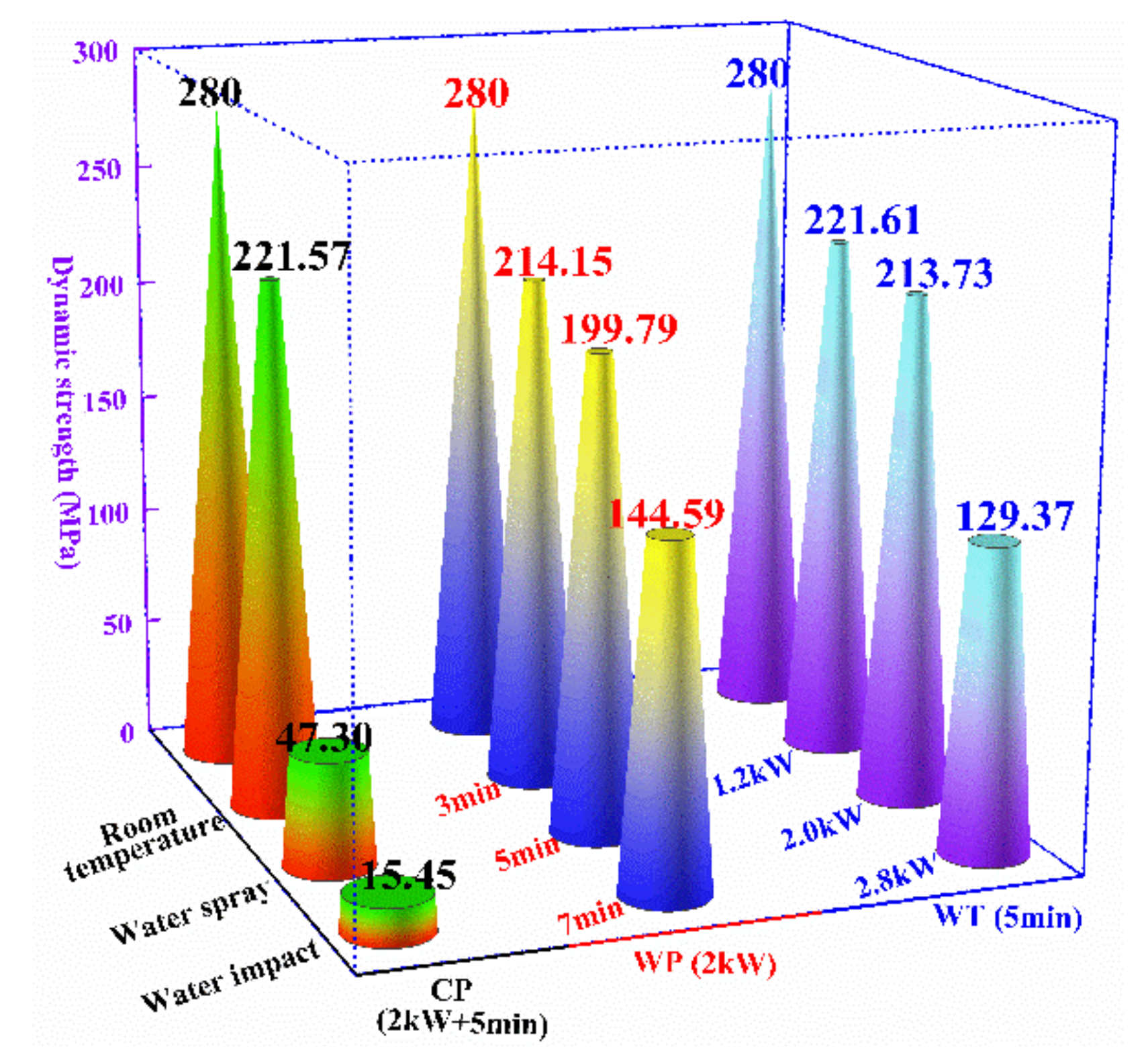
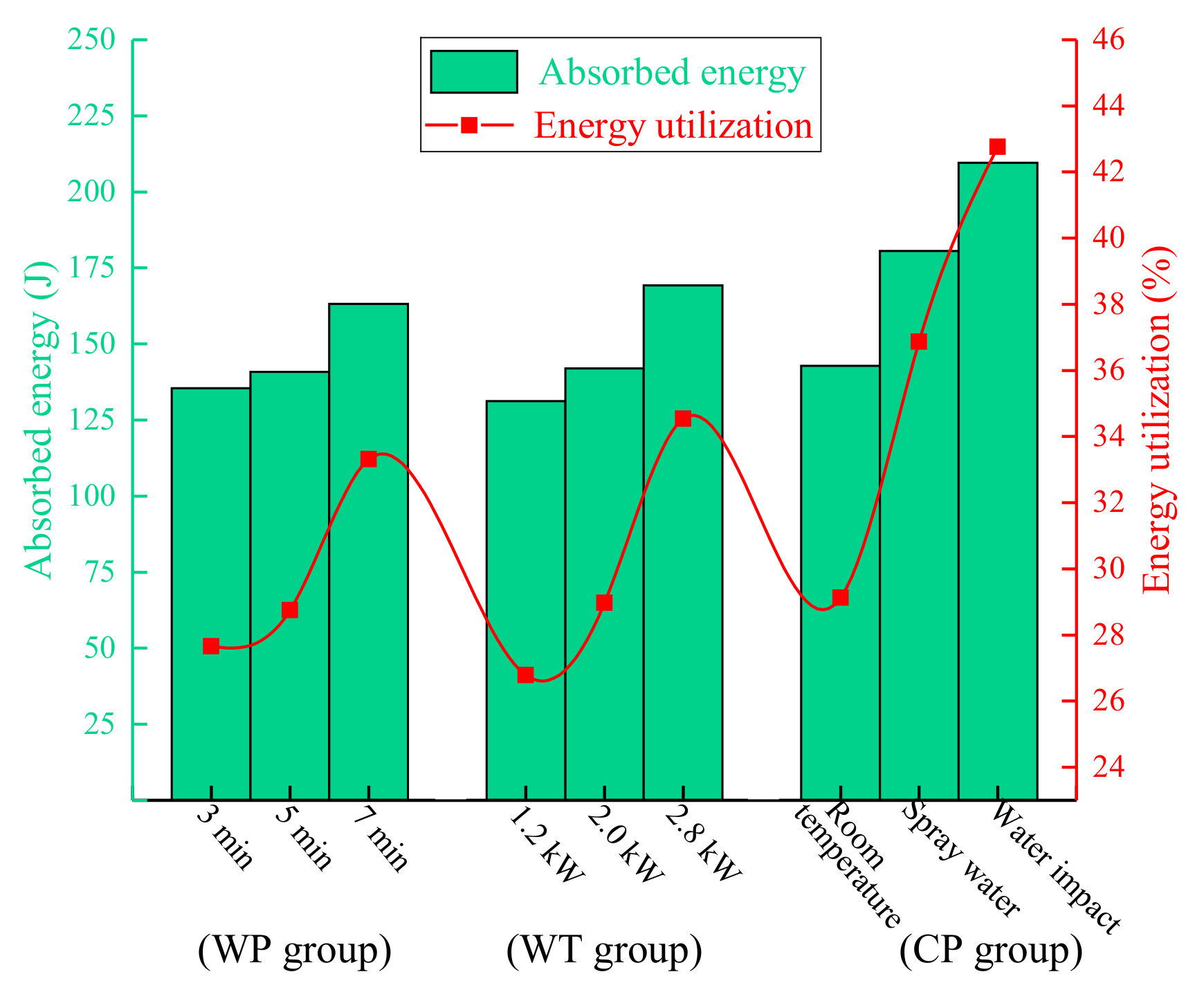
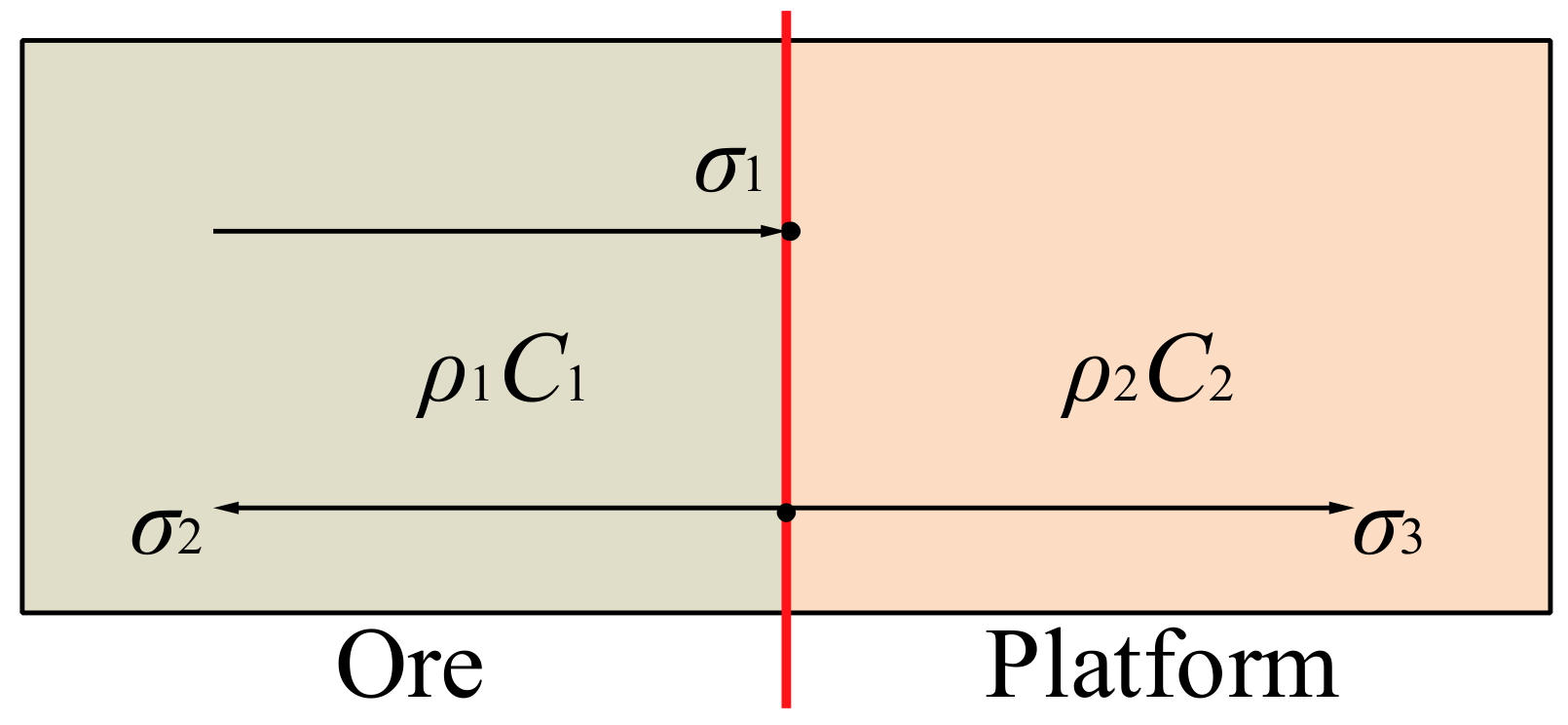

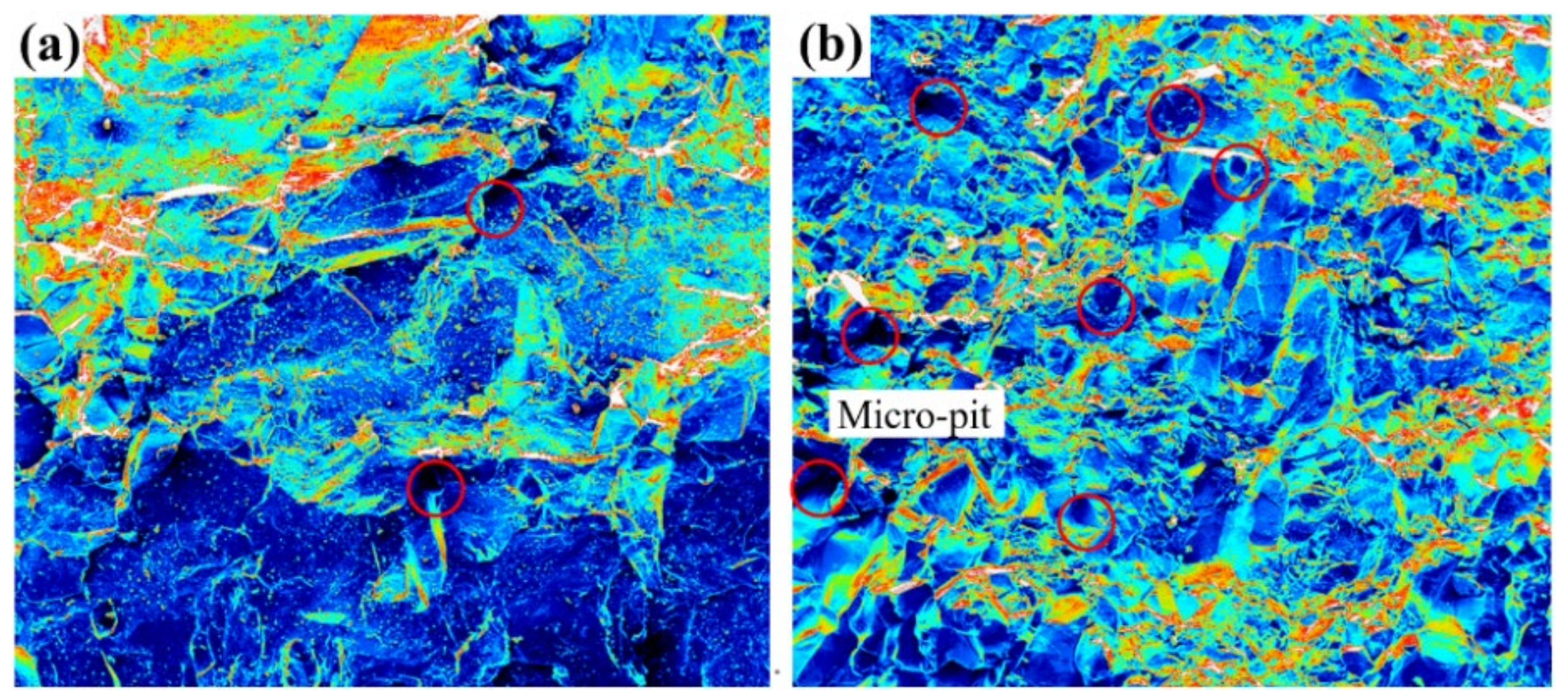

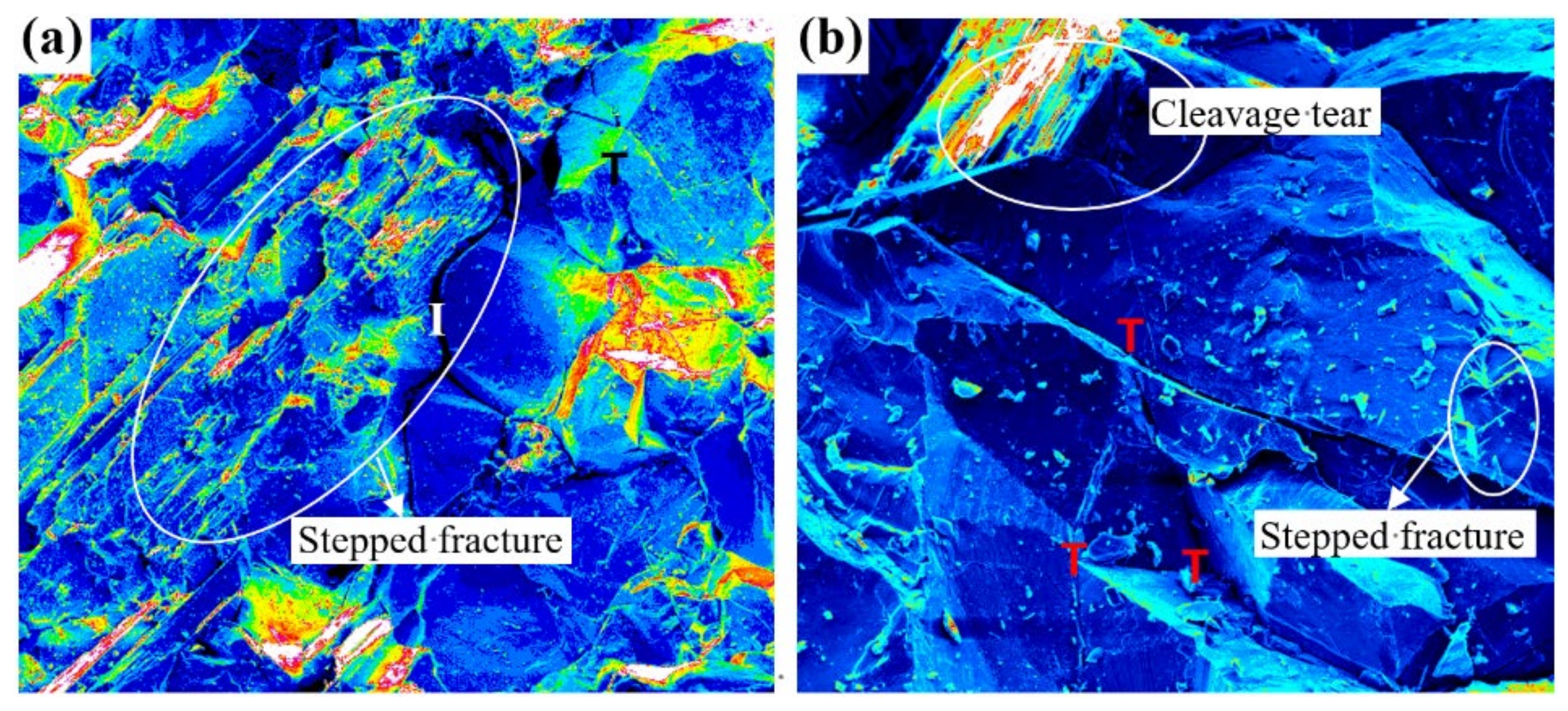

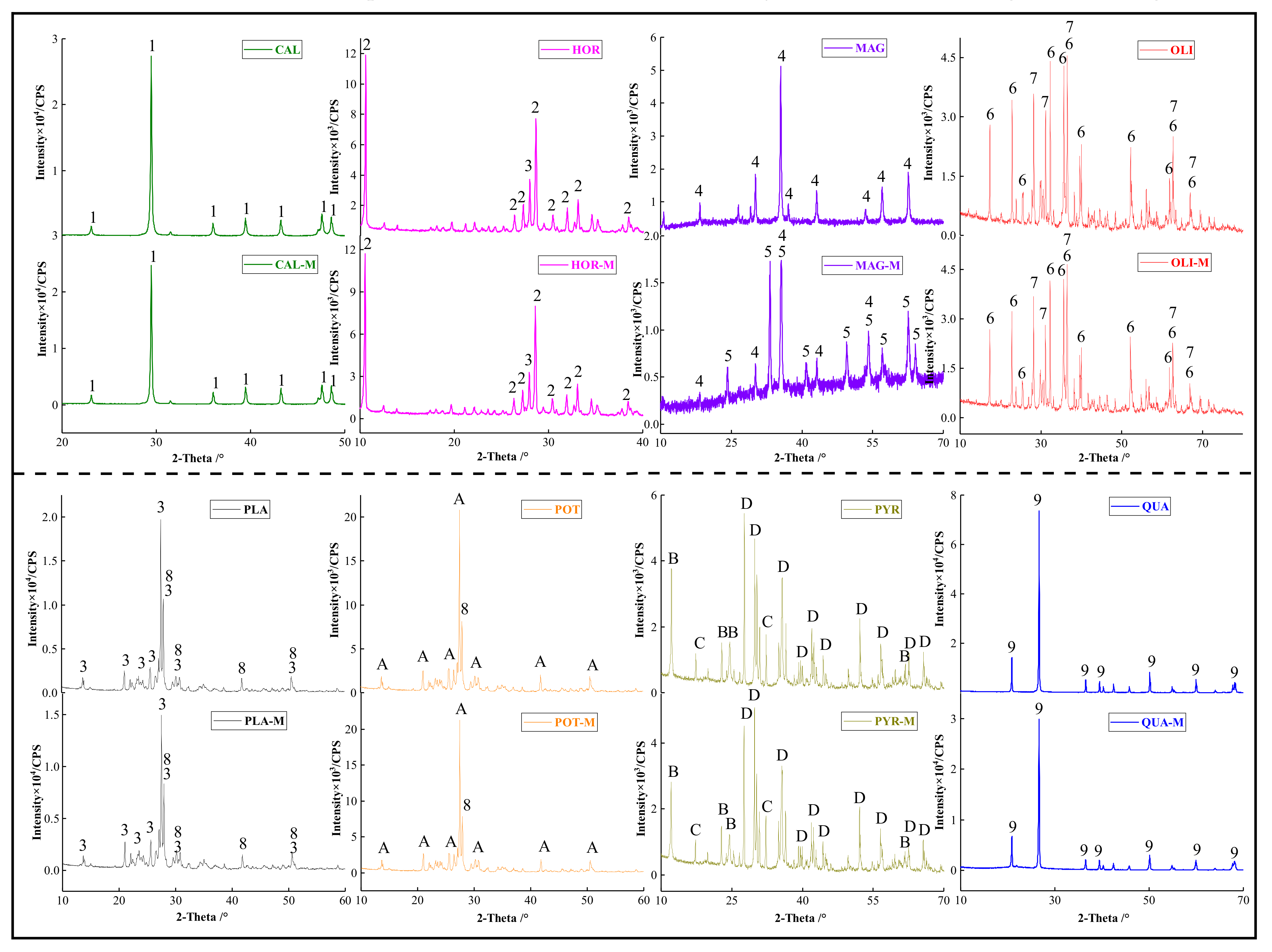
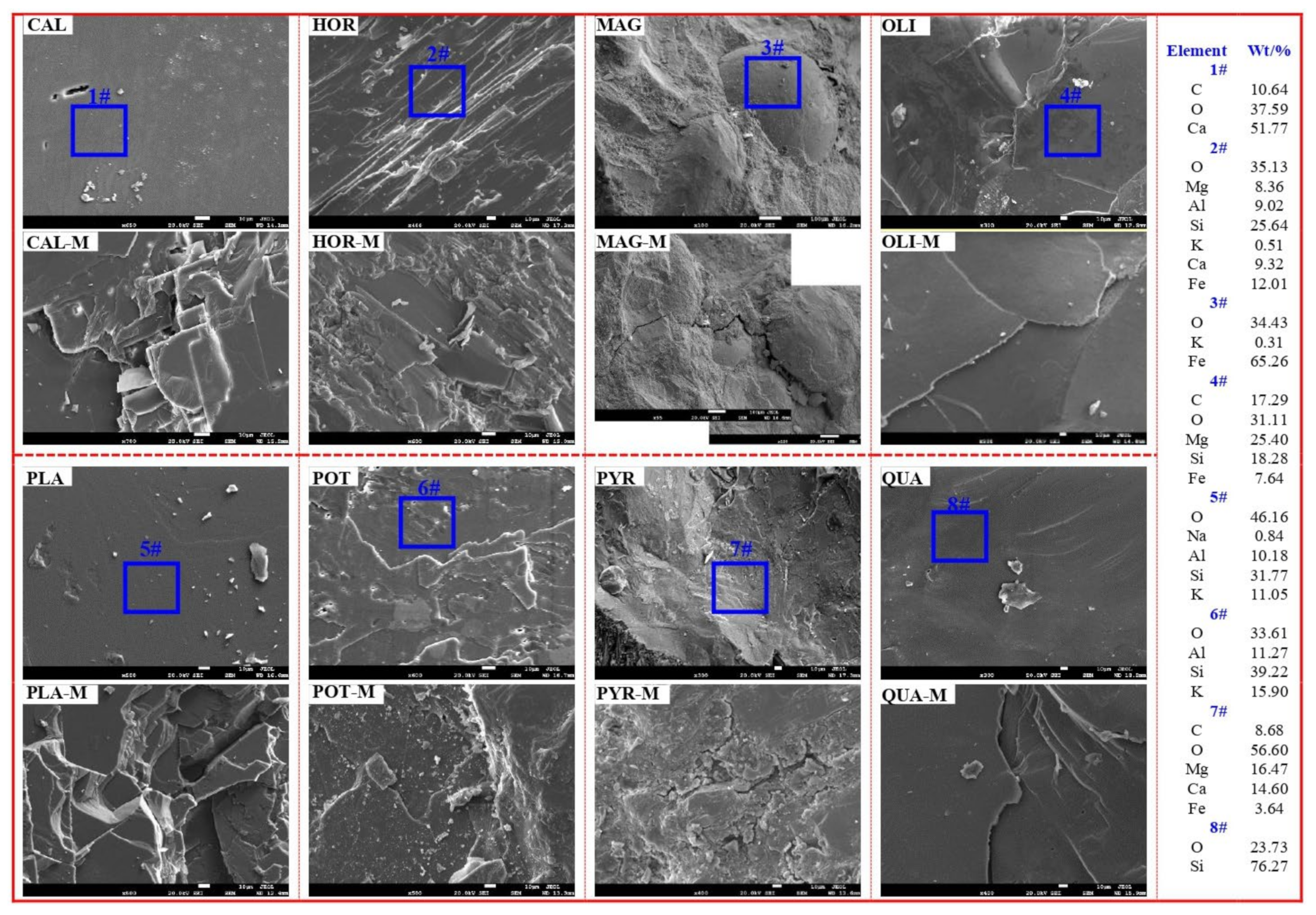

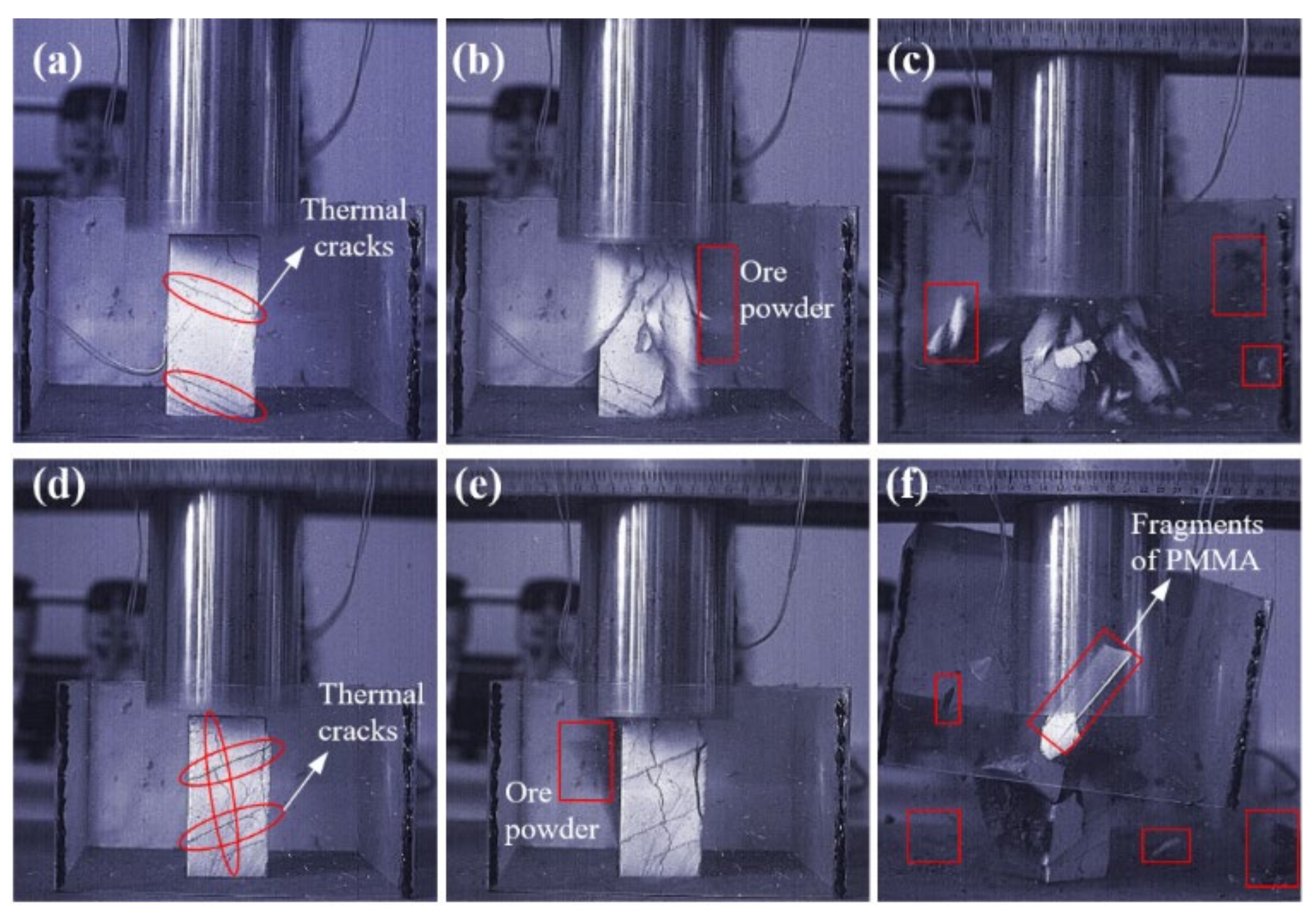


| Group | Power/kW | Heating Time/min | Cooling Path | Number | Mass/g | Density/g·cm−3 | Wave Velocity/m·s−1 | Size/mm |
|---|---|---|---|---|---|---|---|---|
| WP | 2.0 | 3 | Room temperature | WP-3-1 | 815.29 | 3.25 | 3598 | 5.03 × 5.06 × 9.86 |
| WP-3-2 | 821.34 | 3.32 | 3682 | 4.98 × 5.02 × 9.90 | ||||
| WP-3-3 | 821.51 | 3.24 | 3596 | 5.02 × 5.05 × 9.99 | ||||
| 5 | WP-5-1 | 820.99 | 3.31 | 3677 | 5.03 × 4.93 × 10.00 | |||
| WP-5-2 | 825.51 | 3.32 | 3688 | 4.96 × 5.03 × 9.96 | ||||
| WP-5-3 | 818.02 | 3.28 | 3637 | 4.96 × 4.98 × 10.10 | ||||
| 7 | WP-7-1 | 821.78 | 3.26 | 3602 | 5.08 × 4.96 × 10.01 | |||
| WP-7-2 | 818.80 | 3.21 | 3574 | 4.99 × 4.97 × 10.27 | ||||
| WP-7-3 | 813.69 | 3.20 | 3559 | 4.97 × 5.09 × 10.05 | ||||
| WT | 1.2 | 5 | Room temperature | WT-1.2-1 | 816.49 | 3.23 | 3732 | 5.03 × 5.06 × 9.93 |
| WT-1.2-2 | 822.37 | 3.30 | 3668 | 4.99 × 4.92 × 10.16 | ||||
| WT-1.2-3 | 821.30 | 3.29 | 3651 | 5.11 × 4.91 × 9.95 | ||||
| 2.0 | WT-2.0-1 | 817.15 | 3.26 | 3586 | 5.07 × 5.02 × 9.85 | |||
| WT-2.0-2 | 815.32 | 3.29 | 3644 | 5.02 × 4.96 × 9.95 | ||||
| WT-2.0-3 | 822.75 | 3.32 | 3705 | 5.01 × 5.05 × 9.80 | ||||
| 2.8 | WT-2.8-1 | 822.31 | 3.31 | 3679 | 5.03 × 4.97 × 9.93 | |||
| WT-2.8-2 | 819.56 | 3.28 | 3640 | 5.02 × 4.96 × 10.04 | ||||
| WT-2.8-3 | 820.06 | 3.35 | 3729 | 4.94 × 4.91 × 10.09 | ||||
| CP | 2.0 | 5 | Spray water (SW) | CP-SW-1 | 821.66 | 3.28 | 3628 | 4.96 × 5.03 × 10.03 |
| CP-SW-2 | 817.15 | 3.30 | 3657 | 5.10 × 4.82 × 10.07 | ||||
| CP-SW-3 | 820.53 | 3.26 | 3615 | 4.89 × 5.14 × 10.01 | ||||
| Water impact (WI) | CP-WI-1 | 818.75 | 3.34 | 3620 | 5.07 × 4.88 × 9.90 | |||
| CP-WI-2 | 820.44 | 3.33 | 3714 | 4.92 × 5.11 × 9.80 | ||||
| CP-WI-3 | 817.34 | 3.24 | 3596 | 4.99 × 5.02 × 10.06 |
| Groups | Heating Path | Cooling Path | Microstructure | Fracture Mechanism | Energy Consumption |
|---|---|---|---|---|---|
| WP | 2KW + 3min | Room temperature | Step-like morphology | I-fractures | Low |
| 2KW + 5min | |||||
| 2KW + 7min | Lamellar tear | T-fractures, lamellar tear | Medium | ||
| WT | 5min + 1.2 KW | Shell-like and step-like | I-fractures | Low | |
| 5min + 2.8 KW | Cleavage tear, flat morphology | T-fractures, cleavage tear | Medium | ||
| CP | 2KW + 5min | Spray water | Flat morphology, micro-pits | T-fractures | High |
| Scheme Name | Number of Ore | /mm | /mm | /mm | /mm |
|---|---|---|---|---|---|
| MSI-A | 3 | 250 | 350 | 450 | 1050 |
| MSI-B | 3 | 350 | 250 | 450 | 1050 |
| MSI-C | 3 | 450 | 350 | 250 | 1050 |
| SSI | 3 | 0 | 1050 | ||
Publisher’s Note: MDPI stays neutral with regard to jurisdictional claims in published maps and institutional affiliations. |
© 2021 by the authors. Licensee MDPI, Basel, Switzerland. This article is an open access article distributed under the terms and conditions of the Creative Commons Attribution (CC BY) license (https://creativecommons.org/licenses/by/4.0/).
Share and Cite
Hao, J.; Li, Q.; Qiao, L. Study on Magnetite Ore Crushing Assisted by Microwave Irradiation. Minerals 2021, 11, 1127. https://doi.org/10.3390/min11101127
Hao J, Li Q, Qiao L. Study on Magnetite Ore Crushing Assisted by Microwave Irradiation. Minerals. 2021; 11(10):1127. https://doi.org/10.3390/min11101127
Chicago/Turabian StyleHao, Jiawang, Qingwen Li, and Lan Qiao. 2021. "Study on Magnetite Ore Crushing Assisted by Microwave Irradiation" Minerals 11, no. 10: 1127. https://doi.org/10.3390/min11101127






